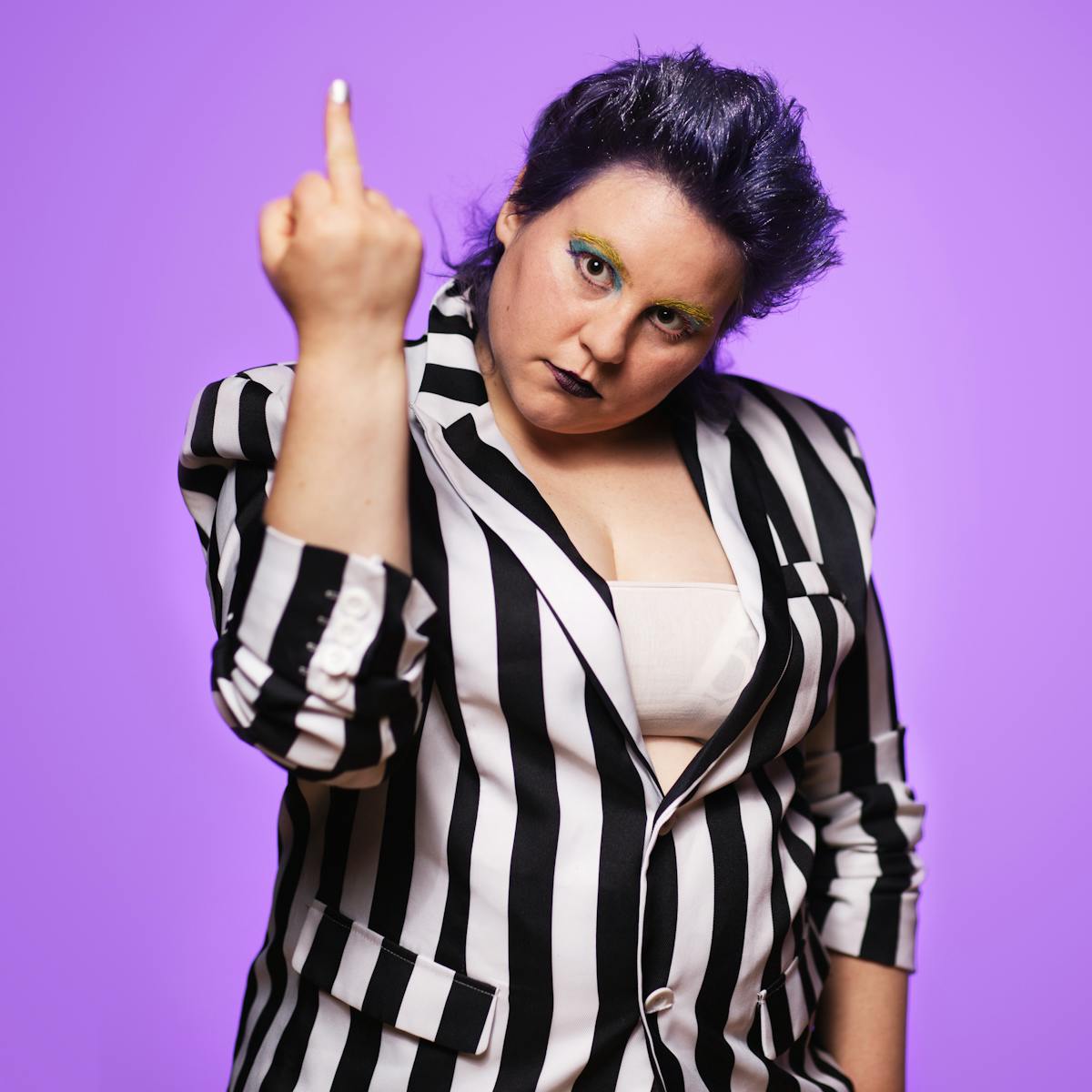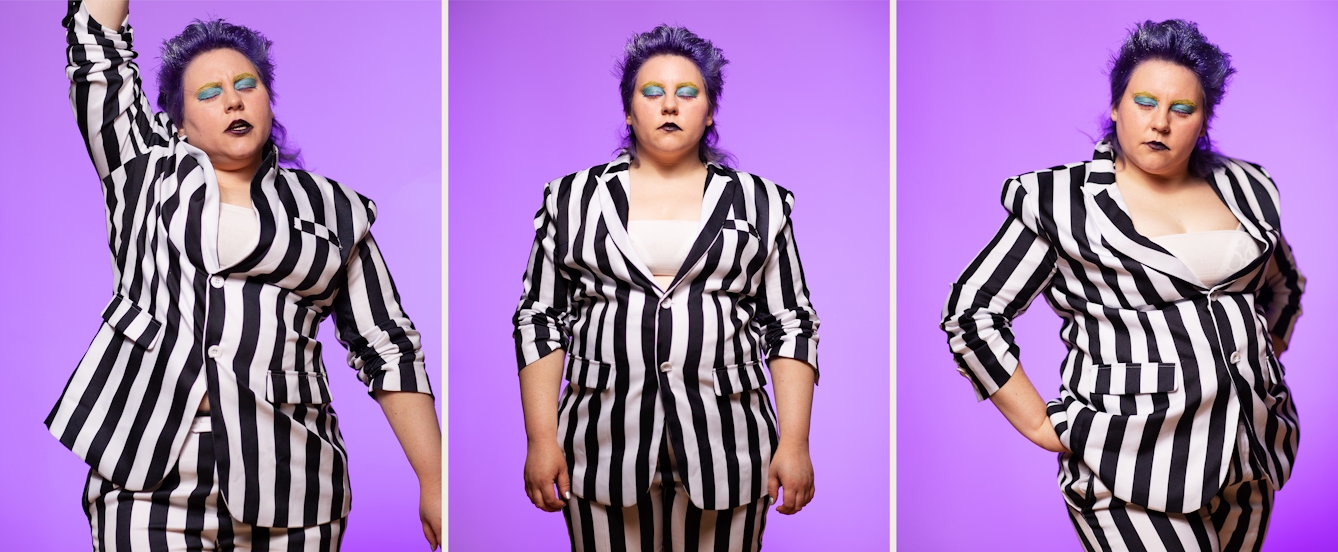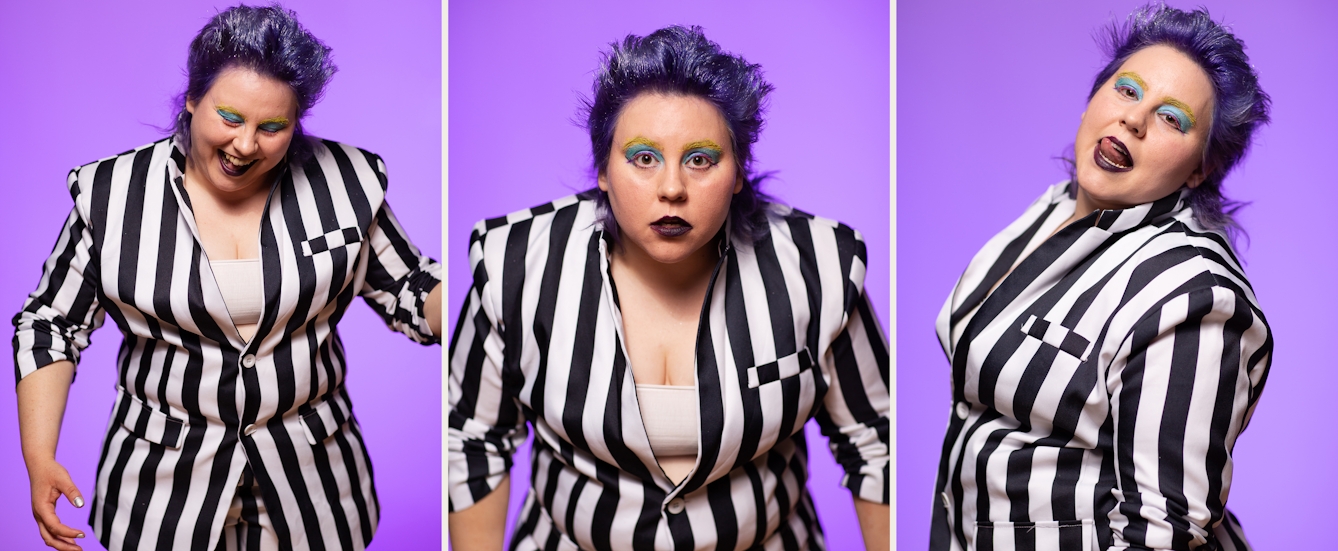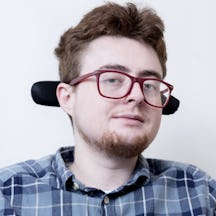Autistic and learning-disabled creatives are an essential part of the artistic world, but they are often underserved. Jamie Hale talks to performer and director Emma Selwyn about creating work that celebrates, rather than suppresses, autistic behaviours, and about the joy of acceptance.
The freedom to provoke
Words by Jamie Halephotography by Stephen Allwrightaverage reading time 5 minutes
- Article

Listen
Xandri stands on stage with three fellow autistic and learning-disabled artists. The four of them rattle charity buckets at the audience, competing to collect the most tokens. The show is ‘Not F**kin’ Sorry’, created by Not Your Circus Dog. Later, the performers strip to their underwear as a group, dancing joyfully.
In their solo show, ‘My Hands and Feet are Wiggling’, Xandri paces, flaps and celebrates their autistic behaviours. Here, autism isn’t shameful or hidden – it’s central to their performance and the root of their power.
Xandri is the performance name used by Emma Selwyn, who also works as a director. They belong to Access All Areas, a theatre company for autistic and learning-disabled artists. I wanted to talk to Emma about the challenges facing autistic and learning-disabled performers and creatives, who are an essential part of the artistic world but are often underserved.
Collaboration and co-production
Finding Access All Areas changed, and possibly even saved Emma’s life. They tell me that they “wonder on and off whether I’d even be here if it wasn’t for Access All Areas”, highlighting the importance of spaces where people can find their peers.
Emma had tried working at a bank and building what they call a “picket-fence life”, but this was leading them to a breakdown. Their decision to become an artist was motivated by misery and a desire for transformation. The art world was the first place they’d felt “the joy of reclaiming who I actually was because [before] I had had to behave in as normative a way as possible”. In Access All Areas, “my peers accepted me and my ’isms”.

“Finding Access All Areas changed, and possibly even saved Emma’s life.”
Having acted for most of their life, mentored by neurodivergent director Liselle Terret, Emma started training at Access All Areas in 2016. After completing a Performance Making Diploma run through the Royal Central School of Speech and Drama, they applied for a role as a trainee co-director of Access All Areas’ Performance Company, working alongside artistic director Nick Llewellyn on several projects.
Access All Areas works on what could be described as a model of co-production – not everyone working there is learning-disabled or autistic, but the company tries to ensure everything is led by people who are. They use a model of work that they built from the ground up to be adaptive and collaborative, instead of simply trying to apply the standard model to neurodivergent artists. This gives their artists the opportunity to decide to develop challenging, provocative work that might be controlled or deemed inappropriate by another arts organisation.
Illuminating ‘invisible’ disability
As Xandri, Emma is a master of challenging work. I’ve found with my own work that it’s important to push a non-disabled audience to engage with what I experience as a disabled person – but Xandri takes this to a new level. In ‘My Hands and Feet are Wiggling’ they select audience members and accuse them of “repetitive behaviours”. By doing this, Xandri challenges the audience to consider their complicity in medicalised discussions about neurodivergence, which discourage ‘stimming’ – repetitive movements or noises that bring someone joy or calmness.
Before Xandri found disability arts, ‘stimming’ was a dirty word; here, it is welcome and forms the centre of their show. The show is based around a translation of a Korean song called ‘Sonbari ogulogul’ by K-hip-hop artist Tymee. Xandri explains that the title translates in multiple ways, literal and metaphorical. Literally, it means “my hands and feet are wiggling”, but it also encapsulates ideas of enforced shrinking or cringing (the English title for the song is ‘Shrinking’) – as well as the joy of sound and stimming.
The song was written during a dark period in Tymee’s life. The show Xandri has built around it encapsulates their own joy at finding Access All Areas and at being able to celebrate their autistic behaviours as art, rather than having to suppress them.
Autism is often described as an ‘invisible’ disability, but for Xandri, their experience is very visible. They explain that, for them, being disabled isn’t about having specific limitations, it’s about the way people treat them like “a circus dog from uncanny valley” – something I can closely relate to.

“To see an artist like Emma creating work that is beautiful because they’re disabled has been so refreshing.”
The unwritten rules of theatre
As a director, Emma (the name they use for this part of their work) has faced significant barriers. They started their role just as the pandemic hit, and they’ve struggled with ‘cliques’ in the theatre world. The level of formality is disorientating for them, and they’ve found a “certain way of being as a director that you can’t let slip”.
Part of that is Emma’s admirable approach to caring for their performers – they tell me that “the director has to be responsible for themselves and others, and others at the expense of themselves”, but another part is how other directors judge them. We talk about trying to follow the unwritten rules in theatre, and how much we’ve both struggled to understand them. It feels like a mysterious world.
To see an artist like Emma creating work that is beautiful because they’re disabled has been so refreshing, and feels like an ideal way to end this series. I’ve been able to speak to people who reflect multiple and varied facets of the disabled experience, and hopefully I’ve shone a light on some of the most important voices emerging today.
It’s been a learning process for me – one that’s forced me to come to terms with my own impairment, and the power and importance of great d/Deaf and disabled artists. The arts world is slowly opening up to us, and the artists I’ve spoken to, young and old, regardless of genre, have reminded me that while each can only reflect their own experiences, there is an incredible variety of d/Deaf and disabled artists performing across a broad artistic spectrum.
While everyone’s needs and position as a disabled person are different, we all face access barriers – and by breaking those down, we can all make art.
About the contributors
Jamie Hale
Jamie is an artist, curator, and founder and artistic director of disability arts organisation CRIPtic Arts. They create poetry, comedy, scriptwriting and drama for page, stage and screen, and are currently directing a showcase at the Barbican Centre for autumn 2021 and a disability arts documentary. They have written for Wellcome Collection and the Guardian newspaper and have performed at venues including the Southbank Centre. Their poetry pamphlet, ‘Shield’, was published in January 2021.

